Description of the columnar apple tree and its cultivation

Many gardeners plant various varieties of apple trees on their land plots. The columnar apple tree is gaining more and more popularity. Today we will talk about the main characteristics, features of this culture, its advantages and disadvantages.

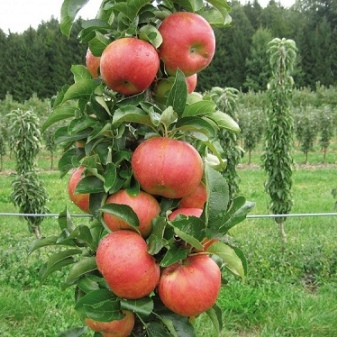
What it is?
To begin with, let's take a closer look at the description of columnar vegetation. It is a variety in which branches are placed against the surface of the trunk at sharp angles. The branches are pressed into the bark, in its shape this species is very similar to the pyramidal poplar. It looks like a column, which is what this name means.... The height of the columnar apple tree depends on which stock was used to grow the seedlings. The average height of the crop is 2.5 meters. Dwarf species stop growing from about 3-4 years old.
For a season, one such fruit tree can be harvested about 10-15 kilograms of ripe fruit. Such trees are able to actively and fully grow up to 15 years. By this time, depletion begins to occur, the yield drops dramatically. In this case, only nutritious feeding will help. Such trees have a fibrous root system. It is located at a shallow depth, so these plants will be in dire need of regular abundant watering.
At the same time, it is important that there is no stagnation of moisture in the trunk circle.
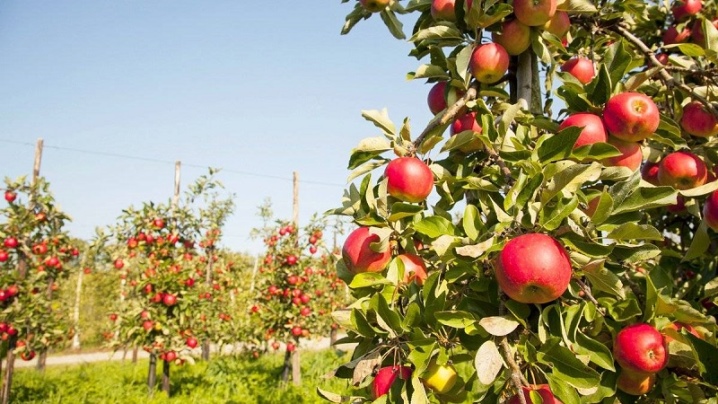
Advantages and disadvantages
Next, you should highlight the main advantages of such an apple tree.
- Small size. Such trees are considered compact enough, they will not take up much space on your land, therefore they are very popular among owners of small household plots.
- High yield level. Despite its diminutive size, this crop allows you to get a large full-fledged crop.
- Frost resistance... Saplings with frost-resistant rootstocks can easily withstand the harsh climatic conditions.
- Comfort... Small growth and compact size make the fruit picking process much easier.
But the columnar apple tree also has some significant disadvantages.
- Terms of life. This variety differs from ordinary species in a much shorter life span. With proper care, simple trees can bear fruit for 40-50 years. Columnar species live much less.
- Price... Saplings of such an apple tree will be quite expensive compared to conventional varieties.
- Exactingness... This culture will require special good care: periodic abundant watering, the use of appropriate fertilizers, the creation of special shelters.

The best varieties
Next, we will consider the features of some individual types of columnar apple trees.
Early
In this group, some species should be distinguished separately.
- Nectar... This early variety is miniature in size. He is fast-growing. The crown diameter reaches 25 centimeters. This type allows you to get the maximum yield. Medok tolerates frosts down to minus 42 degrees.
- The president... Such a summer variety will be the best option for growing in the middle lane. It has increased resistance to various diseases and fungal infections. Its fruits have a sweet and sour pleasant taste. They completely cover the entire tree down to the ground.
- Iksha... This species is winter-hardy.It has small but juicy and tasty fruits. But this culture will need protection from scab, as it is often exposed to this disease.
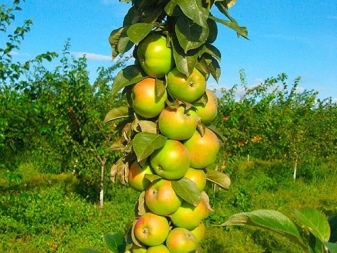

Autumn
Next, we will consider the autumn varieties of such an apple tree.
- Moscow necklace. This culture has the most compact size. It is quite hardy. The variety will need pollinators, as well as preventive spraying, but at the same time it will begin to bear fruit in the first year after planting.
- Chervonets... Such an autumn dessert type allows you to get a large harvest of large sweet apples with a creamy tender pulp. The variety cannot boast of high frost resistance, but at the same time, in case of damage, it can easily and quickly recover.
- Vasyugan... This columnar apple tree also belongs to the dessert varieties. She can easily transfer temperatures down to minus 40 degrees. This fruit crop is suitable for growing in the Urals and the Far East.
- Ostankino... The compact variety has a fairly high yield level. During the season, about 16 kilograms of ripe apples can be removed from one such tree. Ripe plucked fruits can be stored almost until the middle of the winter season.
- Baby... This type of variety is a dessert variety. It is considered one of the most compact. The variety allows you to get a full harvest of small yellow-orange apples. It will be perfect for the southern regions.
The baby is highly resistant to extreme heat and sunburn.


Winter
Now let's note the features of some winter varieties of the columnar apple tree.
- Currency... The variety will be suitable for the middle lane. It ripens with sweet fruits with a slightly sour aftertaste. The culture has a high resistance to severe frosts and scab. In addition, these plants are particularly decorative, therefore they often act as an interesting decoration on the land.
- Bolero... This variety is distinguished by large green fruits, the mass of one fruit can reach about 200 grams. The species has a firm, but very juicy white flesh. Up to 20 kilograms of ripe fruits can be harvested from one tree per season.
- Yesenia... This variety is particularly resistant to scab and frost. The fruits of the variety are quite large, each weighing an average of 170 grams. On ripe fruits, you can see a light waxy coating of dark red color.
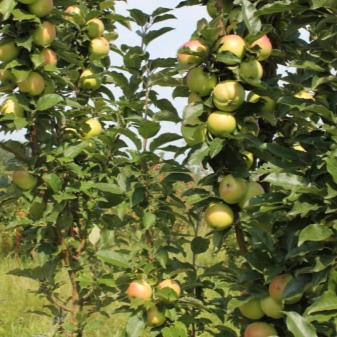

Landing
Let's analyze the scheme of planting a columnar apple tree.
Autumn
Let's start by planting in the fall season. Remember to plant a columnar crop in rows. In this case, it is necessary to leave free space between neighboring seedlings of 0.5 meters, between rows - 1 meter. Planting holes are dug two weeks before planting depth and diameter of 90 centimeters. When digging, the top layer of soil is folded separately, it will be needed when creating a soil mixture.
If the ground is too heavy or clayey, drainage must be done. This will prevent rotting of the root system of the trees. To do this, broken crushed stone, previously mixed with clean sand, is laid at the bottom of each pit. The thickness of such a layer should be about 10-15 centimeters.... The fertile soil layer is mixed with humus and compost. Pour about 100 grams of superphosphate and top dressing with potassium there. It is also best to add one glass of dolomite flour.
Pour half of the resulting mixture into the planting hole. All this must be carefully leveled and left in this form for a couple of weeks to shrink and compact the earth. After another two weeks, they begin directly to planting. To do this, first pour out the rest of the soil mixture. After that, the seedlings are installed. This should be done in such a way that the roots are evenly distributed over the mound. In this case, the vaccination site should be located above ground level.
Having departed from the trunk about 25-30 centimeters, an earthen rampart 15 centimeters high is formed around the perimeter... It is needed in order to prevent moisture leakage during watering. Young seedlings are watered with settled water. In this case, one tree should have 1-2 buckets. When all the water has been absorbed into the soil, mulch is sprinkled on the near-stem circle; you can use cut grass, peat and sawdust as it.


Spring
Now we will analyze how to properly plant a columnar apple tree in the spring season. In this case, the landing technology is practically no different from the previous version. But at the same time, the planting holes must be prepared already in the fall. During the winter, the soil will be well compacted, and the top dressing will dissolve and be absorbed into the soil. Preliminary preparation of the planting holes will allow the culture to take root much faster. Seedlings that are planted in spring often bloom in the same spring.
In any case, it is worth remembering that such apple trees prefer areas well-lit by the sun. In the shade, such a culture is practically not planted. In addition, the selected place must be reliably protected from the winds.


Care
In order for the columnar apple trees to grow well in your country house, you should remember the rules of care.
- Spring... During this period of the year, old dry and damaged branches are pruned. They also spray the crown of trees and the trunk with special ready-made preparations to protect the vegetation from various diseases and harmful insects. In the spring, it is recommended to apply fertilizers with nitrogen. In young plants of the first year of life, the buds are cut off. We must not forget about periodic abundant watering and loosening of the near-trunk circle. You also need to thin out the buds.
- Summer... During this period, special complex mineral dressings should be used. It is also necessary to re-thinning the buds, only half of the ovaries are left. When the fruits are the size of a cherry, a small part of the ovaries is removed. There should be only two of them in each inflorescence. When the fruit is the size of a walnut, one of them is removed. In the summer season, you need to regularly carry out preventive examinations. If signs of diseases or harmful organisms are detected, fruit trees should be immediately sprayed with special ready-made preparations, sometimes they use homemade folk medicinal infusions. In August, it is worth applying fertilizers with potassium, it is absolutely impossible to apply nitrogen fertilizers. About a month before harvesting, the vegetation should not be treated with insecticides or fungicides either.
- Autumn... At this time, it is necessary to shorten the upper shoots, all fruit plants are sprayed with medicinal compounds to protect them from fungal infections. The crown, the trunk circle and the trunk must be carefully processed from pests that live in the bark and in the ground. If necessary, you can carry out repeated sanitary pruning of vegetation. Before the onset of winter frosts, the culture is covered with spruce branches. When the first snow falls, they need to cover the base of the trunk. Straw cannot be used as such a covering material, because rodents can climb into it, which will damage the bark of trees.
If you previously used straw as mulch, then before the onset of frost, it must be removed.


For processing such apple trees, you can use a variety of compounds (biological, chemical, folk). Urea solutions (7%) are often used. They will act as a fungicide and insecticide. Also, this solution is often taken as a nitrogen supplement. Bordeaux liquid is sometimes used (1%). But it should be used only in the fall after the leaves have fallen and in the spring before the start of the sap flow process.
It is important to remember about watering. After all, columnar varieties do not have a taproot, due to which vegetation can extract water from the depths of the earth. Young plants are watered every three days. If there is a heat for a long time, then watering is carried out every two days. Adult and mature plants can be watered once a week. Starting in mid-July, the amount of watering can be slightly reduced. Since the beginning of August, they have been completely stopped. Drip irrigation is sometimes used. But in any case, at least once a month, it is recommended to carry out a simple abundant soil moistening.
Fertilizers also play an important role. For columnar apple trees, solid fertilizing is the best option. They are buried in the ground to a depth of about 2-3 centimeters. Before bud break, it is better to use a nitroammophoska. If the trees were planted on poor soils, then you can also take humus (2-3 buckets for each plant). Next, you can use superphosphate, potassium chloride.
As an additional fertilizer, wood ash is often taken. Moreover, for each fruit tree there should be two full glasses. You can also use biological products, herbal infusions.
Remember that after each feeding, the plant must be watered and mulched abundantly. Due to the sufficient amount of water, nutrient fertilizers will not burn the root systems of trees, while mulch will prevent moisture evaporation.


Sanitary pruning of crops also plays an important role. The pruning scheme directly depends on the age of the plant, as well as on the degree of thickening and the season. Old trees are best cultivated during the winter season so that they can release new healthy branches by spring. If you are pruning in the spring, remove any frozen branches with a pruner. When carrying out this procedure in the fall, you must first tear off all leaf blades and side shoots immediately after planting. For the next season, young shoots with a length of more than 30 cm are slightly shortened, each of them should have 2-3 buds.
In the third year, all branches over 40 cm should be thinned out. All shoots growing in the inner part of the crown are removed. In the fourth year, all branches are thinned out. Only the strongest and healthiest young shoots are left. In summer, sanitary pruning is done by hand. It will be necessary to pinch new branches from the sides. At the same time, shoots that have been damaged by rot, rust are removed.
During winter processing, they first retreat upward from the surface of the soil about 50-70 cm, choose the strongest shoot. About 5 cm retreat upward from it and cut the conductor in the center into a ring. This will transfer the tree to a young shoot. All cuts must be processed with garden pitch. Otherwise, you can get an infection.


Reproduction
The columnar apple tree can reproduce in a variety of ways.
- With the help of seeds. This option is considered the most ineffective, since it takes a lot of time, but it does not guarantee the formation of a tree with varietal properties.
- Grafting on the stock. This method is used by experienced gardeners. In this case, dwarf parts and local seedlings should be used as a rootstock.
- With the help of air layers. In this case, you can take horizontal layers, in the spring rootstocks are planted and pruned into 2-3 buds, shoots grow in the places of the cuts. Vertical cuttings are sometimes used and can be obtained from uterine shoots that have been pruned in the spring.
In the summer season, new young shoots grow, which must be cut off and planted in the fall.


Diseases and pests
The columnar apple tree can be affected by pests.
- Spider mite. This parasite begins to suck the juices from the leaf plates. In this case, a small and thin web appears on the seamy side. To combat spider mites, it is better to immediately use ready-made preparations ("Nitrafen").
- Apple moth... This parasite quickly eats the shoots and damages the fruit. To get rid of moths, you need to spray the affected trees with metaphos or chlorophos. Moreover, after a couple of weeks, the procedure should be repeated.
- Aphid... These pests live in entire colonies. They suck the juices from shoots and leaves. To destroy aphids, it is better to use formulations such as Fitoverm or Aktara. In any case, spraying is recommended only in dry weather in the evening, when there is no sun.
The clone-like culture is also often affected by various diseases.
- Powdery mildew. This disease can affect almost the entire aerial part of plants. In this case, the tree will begin to grow poorly, and the yield level will significantly decrease. In this case, you can use Bordeaux liquid.
- Rust... Pouring will be covered with rusty spots. Then they will begin to fall off. In this case, it is recommended to immediately use fungicides.
- Scab... This fungal infection can damage absolutely all parts of the fruit crop. Most often, it appears due to excessive moisture. To fight the disease, you can take Bordeaux liquid.
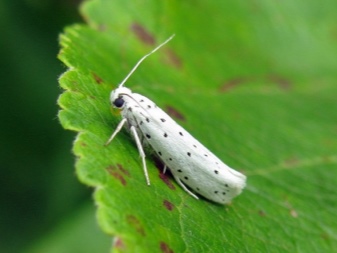

Features of fruiting
This variety of apple trees can bear fruit at different ages. There are species in which this occurs from 3-4 years, for 2 years, for 1 year. The latter are considered early-growing varieties. Many species produce a crop annually, but the frequency may decrease with age. The yield level will also depend on the specific variety, growing conditions, and the age of the trees.
Use in landscape design
Due to their decorative appearance, columnar apple trees are often used as a landscape decoration. At their summer cottage, they are often planted in orderly rows. In the process of flowering, such plants will delight with beautiful small flowers of light shades.
Also, sometimes they form whole dense "walls" in one straight row. The result is a beautiful blooming composition that does not take up too much space on the site.








The comment was sent successfully.